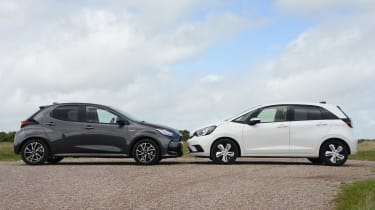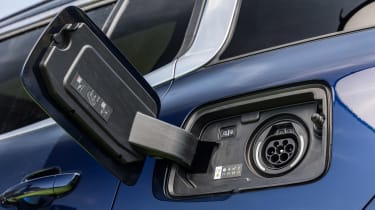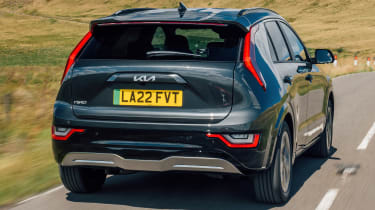Hybrid vs plug-in hybrid vs electric cars
What’s the difference between the three types of electrified car, and which is best for you?
One thing common to hybrids, plug-in hybrids and electric cars is that they all use some form of electrification to make power. Electric cars have been around since the dawn of the automobile, and while hybrid cars have also been around for a similar amount of time, the technology has diversified with different ways of combining combustion engines and electric motors to run cars, with ‘mild-hybrids’, ‘self-charging hybrids’, ‘plug-in hybrids’ all powering cars in different ways. Hybrids, plug-in hybrids and electric vehicles currently benefit from lower or – in the case of EVs until 2025 – zero road tax.
As you might expect, mild-hybrids employ the lightest form of electric assistance, and use motors to merely ease the strain on smaller combustion engines to improve fuel economy and performance, but mild-hybrid cars can’t be driven solely on electric power for any amount of time. For those reasons, we won’t be focusing on mild hybrids in this guide, but you might be wondering; what are the differences between traditional hybrids, plug-in hybrids and fully electric cars?
A ban on the sale of petrol and diesel cars will come into force from 2030, by which point cars which ‘travel a significant distance with zero emissions’ (in other words, hybrid vehicles) will be allowed to be sold until 2035. After that date, no new cars that run on petrol and diesel – even hybrids – can be sold, with fully electric cars to be the most common zero-emissions replacement.
 Top 10 best small hybrid cars 2025
Top 10 best small hybrid cars 2025
Infrastructure is currently one of the greatest hurdles facing plans for a total switch to electric vehicles, however progress is being made. EV car ownership is growing sharply but, for now, hybrid, petrol and diesel vehicles will continue to play a part in new car sales.
Like many other motorists, you may have decided you’d like to make the move to a hybrid, plug-in hybrid or fully electric vehicle, but it’s important to understand the differences between the three; their pros and cons, from practicality to running costs.
We’ve put together a guide to hybrid (sometimes called self-charging hybrid cars), plug-in hybrid and fully electric cars to help you determine which one is best for your current circumstances. Or, you can jump straight to our curated top 10 lists of the best hybrid, best plug-in hybrid and best electric cars.
Hybrid cars
Although the first hybrid car was invented in 1899 by none other than Ferdinand Porsche with the Lohne-Porsche Mixte, the first truly mass-produced hybrid car to hit the market was the Toyota Prius. It went on sale in 1997, yet plenty of manufacturers are still playing catch-up and only just adding hybrid models to their ranges. Here, the Toyota Prius has now been replaced by the Toyota Corolla Hybrid.
Basic hybrid technology hasn’t really changed drastically since the Prius came along, although there have, of course, been improvements in efficiency and implementation. The fundamentals still apply, and hybrid cars come with a petrol or diesel engine that works in tandem with a separate electric motor. They are able to drive with either the electric motor alone, combustion engine alone, or a combination of the two – the on-board computer calculates when and how the different power plants take over.

The battery that powers a hybrid car’s electric motor is relatively small, which means the battery in a hybrid can easily be charged up on the move, either by the engine or electricity generated when the vehicle is coasting or braking. Some people refer to these cars as ‘self-charging hybrids’ for this reason, and the term is an easily understandable way to differentiate them from the plug-in hybrids discussed further down the page.
Mild hybrids arrived later and are slightly different. They have smaller electric motors – usually an adaptation of a petrol/diesel engine’s existing starter motor – that help to provide an acceleration boost when necessary but can’t power the vehicle by themselves.
The pros and cons of hybrid cars
Because hybrid cars can drive only a short distance on batteries alone, and usually not more than a mile or so, they tend to make the most sense in town. Stop-start conditions mean you can creep along in traffic jams in electric mode without adding to the smog but when the congestion eases the engine kicks in to do most of the work.
When you drive out of town the electric motor still helps out during acceleration, and this means you should get more miles out of every gallon of fuel. However, if you tend to drive quickly the advantages can be relatively marginal because the engine will still be working hard.
That’s why many hybrid drivers find their real-world mpg figures are less than they might have hoped, although careful hybrid drivers really can benefit. The same principles apply to mild-hybrid drivers, too.
Although manufacturer claims for mpg and CO2 emissions in hybrids may prove optimistic for many, the low official emissions figures can be hugely relevant to company-car tax payers thanks to the reduced Benefit-in-Kind liability. Government incentives mean you can pay a lot less company-car tax for the hybrid version of a traditionally powered car of equal value.
Of the many advantages hybrid cars offer, many will choose them because they don’t need to change their driving habits or worry about range. Another consideration is that hybrid cars have much smaller batteries. This can help reduce weight and mean they are less costly to manufacture and buy.
‘Mild-hybrids’ will only ever assist the engine, and won’t power the vehicle independently. Drivers of ‘self-charging’ hybrids will save fuel at the most inefficient point of driving, such as in town. A hybrid’s battery and electric motor reduce the engine’s workload in start-stop traffic and assist low-speed acceleration.
Plug-in hybrid cars
The main elements of a plug-in hybrid vehicle (PHEV) are very similar to a standard hybrid car, in that you have an extra battery and electric motor to support the work of a petrol or diesel engine. The main difference is that the battery is bigger, allowing a PHEV to drive much further on electric power alone. The battery’s size means it can’t be recharged by the car as it drives along like a regular hybrid. Instead, just like a fully electric car, you have to plug in a PHEV in order to recharge the battery.
On a full charge, a PHEV will typically allow you to drive between 20 and 60 miles on its battery alone, depending on specification. Once the battery is empty you have to rely on the petrol or diesel engine to continue your journey. You won’t get any significant help from the battery and electric motor until you’ve had a chance to plug in for several hours to recharge but a PHEV will happily drive all day on its petrol or diesel engine.
 Top 10 best plug-in hybrids on sale today
Top 10 best plug-in hybrids on sale today
That is the PHEV’s major selling point; it offers drivers the opportunity to benefit from low-cost and carbon-efficient electric power, without always having to rely on the UK’s still-developing charging networks to complete a journey.
Pros and cons of plug-in hybrid cars
As you can imagine, a PHEV can look tremendously clever if your daily commute is shorter than the electric-only range provided by a fully charged battery. In that case, you could simply charge your car every night at home and never use a drop of petrol or diesel except for occasional longer journeys.
If you do make lots of long journeys, the battery becomes a dead weight when it’s flat, reducing your car’s performance and costing you more in fuel than a standard petrol car might. Under those conditions, a PHEV may not look so clever, especially as the plug-in components can weigh enough to affect the car’s handling.
Talking of performance, lots of PHEVs – like fully electric cars – offer startlingly rapid acceleration. The tech is still relatively expensive and it tends to get fitted to range-topping models, so it’s a great way for manufacturers to offer pricey high-performance cars to business users, as the extremely low emissions figures mean PHEVs attract even lower company car-tax rates than standard hybrids.

Official CO2 and MPG figures are extremely attractive because they’re based on fully charged batteries, and of course, that involves the extra hassle of cables and chargers.
If, as predicted, in a few years we have lighter, faster-charging batteries and a greatly expanded charging network, then it’s likely the PHEV ‘stop-gap’ solution may become less attractive. For now, for the right type of journey, PHEVs are a useful halfway house in the move to fully electric cars.
Electric cars
The number of electric cars is already increasing rapidly on UK roads, so there’s also an increasing amount of choice as manufacturers seek to cash in on demand. These days you can get everything from city cars and superminis, family hatchbacks, executive cars and even SUVs with pure-electric drivetrains. While that means there’s an electric car to suit a wide range of budgets, they’re all linked by the fact that you can’t go anywhere without charging up the battery.
 The 10 best electric cars in 2025
The 10 best electric cars in 2025
Charging times depend on the size of your car’s battery and the rate at which you can charge it, whether at home or using a public charge point. Your driving range is limited by the size of your car’s battery too, so it’s vital to find a model that will meet your own needs.
Pros and cons of electric cars
Zero tailpipe emissions is where cars are headed, so while hybrids and PHEVs are a step in the right direction, you’ll need a fully electric car to meet the government’s – and many drivers’ – ultimate objective. If you own a PHEV or EV and live in a flat or rent your place of residence, the good news is that you may qualify for the EV chargepoint grant, where the government will contribute 75% towards the cost of installing a home wallbox charger, up to a cap of £350.
Electric cars also benefit from extremely low levels of company-car tax, with Benefit-in-Kind set at just 2% until at least April 2024.

Compared to traditional models, EVs can look relatively pricey to buy but as an electric car owner, you’ll benefit from ultra-low running costs, as well as the relaxing and near-silent drive. You will have to get used to the rigmarole of dragging a cable across your garage, drive or sometimes the pavement to keep it charged. However, with EV range from a single charge seemingly increasing with every new model, some EV drivers already only need to charge their car once or twice a week. If your car will drive 300 miles on a full charge and your commute is just 20 miles, why not?
On longer journeys, ‘range anxiety’ and the issue of finding a charger can still make driving an EV stressful. There are over 30,000 public charging points available around the country as we speak, and more are installed every day, but charging still requires extra planning and more time spent plugged into chargers than you would refilling a car with petrol or diesel at a fuel station.
Read our guides to hybrids, plug-in hybrids and electric cars here.
Electric cars made simple
Recommended

New Subaru Trailseeker revealed as rugged electric SUV with 375bhp

New Subaru Solterra brings more range, power and polish
Most Popular
Tips & advice

Car dashboard warning lights: what does each symbol mean?

Electric car charging stations: public networks, charger types, apps and maps









